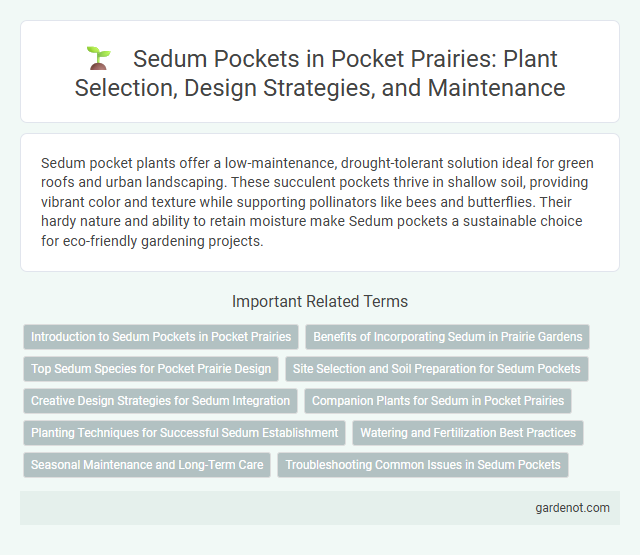Sedum pocket plants offer a low-maintenance, drought-tolerant solution ideal for green roofs and urban landscaping. These succulent pockets thrive in shallow soil, providing vibrant color and texture while supporting pollinators like bees and butterflies. Their hardy nature and ability to retain moisture make Sedum pockets a sustainable choice for eco-friendly gardening projects.
Introduction to Sedum Pockets in Pocket Prairies
Sedum pockets are compact, low-maintenance green installations designed for pocket prairies, offering drought-tolerant succulent species that thrive in small spaces. These pockets enhance biodiversity by providing habitats for pollinators such as bees and butterflies, while requiring minimal soil and water resources. Ideal for urban environments, sedum pockets contribute to sustainable landscaping through effective stormwater management and heat reduction.
Benefits of Incorporating Sedum in Prairie Gardens
Sedum pocket varieties enhance prairie gardens by providing drought tolerance and low-maintenance ground cover, promoting soil health and preventing erosion. Their succulent leaves store water, making them ideal for dry conditions and reducing irrigation needs. Sedum flowers attract pollinators like bees and butterflies, supporting local biodiversity and ecosystem balance.
Top Sedum Species for Pocket Prairie Design
Sedum acre, Sedum album, and Sedum spurium are top sedum species essential for pocket prairie design due to their drought tolerance, low maintenance, and vibrant foliage colors. Sedum floriferum and Sedum reflexum add texture diversity and seasonal blooms, enhancing the aesthetic appeal of pocket prairies. These sedums promote biodiversity, support pollinators, and thrive in shallow soil conditions typical of pocket prairie environments.
Site Selection and Soil Preparation for Sedum Pockets
Sedum pockets thrive in well-drained, sunny locations with at least six hours of direct sunlight daily, making southern or southwestern exposures ideal for optimal growth. Soil preparation requires a gritty, fast-draining substrate, typically a mix of sandy loam and organic matter, to prevent waterlogging and root rot. Ensuring the site has minimal soil compaction and maintaining pH levels between 6.0 and 7.5 promotes healthy Sedum root development and vibrant foliage.
Creative Design Strategies for Sedum Integration
Sedum pocket installations leverage modular design principles to create sustainable green walls that optimize water retention and biodiversity. Incorporating diverse Sedum species with varied textures and colors enhances visual complexity and microhabitats while supporting pollinators. Strategic layering and pattern formation maximize sunlight exposure and growth efficiency, promoting vibrant, resilient living facades.
Companion Plants for Sedum in Pocket Prairies
Sedum thrives alongside native grasses such as little bluestem and prairie dropseed, which enhance soil drainage and provide structural contrast in pocket prairies. Wildflowers like purple coneflower and black-eyed Susan complement Sedum by attracting pollinators and adding vibrant seasonal color. These companion plants collectively support a balanced micro-ecosystem, promoting biodiversity and resilience within pocket prairie habitats.
Planting Techniques for Successful Sedum Establishment
Sedum pocket planting techniques emphasize well-drained, sandy soil with optimal sunlight exposure to promote healthy growth and drought resistance. Incorporating a thin layer of organic mulch helps retain moisture while preventing root rot in Sedum varieties. Regular spacing of 6-12 inches enhances air circulation and reduces competition, ensuring successful Sedum establishment in pocket prairie gardens.
Watering and Fertilization Best Practices
Sedum pocket plants thrive with minimal watering, requiring well-drained soil to prevent root rot; water only when the top inch of soil feels dry to the touch. Fertilize sparingly using a balanced, slow-release fertilizer during the growing season to promote healthy growth without encouraging excessive foliage. Avoid overwatering and excessive fertilization to maintain the succulent's natural drought-resistant characteristics and vibrant appearance.
Seasonal Maintenance and Long-Term Care
Sedum pocket plants require minimal seasonal maintenance, thriving with occasional pruning and removal of dead foliage to promote healthy growth and vibrant blooms. Regular watering during dry periods supports their drought-tolerant nature, while well-draining soil prevents root rot, ensuring longevity. Over several years, dividing crowded pockets maintains plant vigor and encourages sustained ground coverage in pocket prairie installations.
Troubleshooting Common Issues in Sedum Pockets
Sedum pockets often face issues such as poor drainage, leading to root rot and fungal diseases commonly caused by overwatering or compacted soil. Address water retention problems by ensuring well-draining substrates and avoiding excessive irrigation to maintain plant health and prevent yellowing or wilting leaves. Monitor for pests like aphids and spider mites, which can be managed through natural predators or insecticidal soaps to preserve the integrity of the pocket prairie.
Sedum pocket Infographic

 gardenot.com
gardenot.com